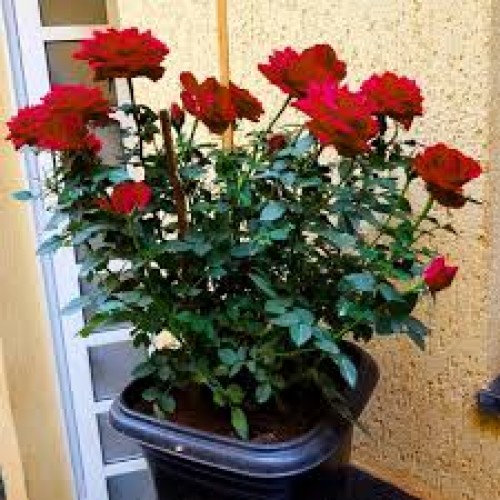off
-
Sold
-

-

out
Rose Plant: Nature, Care & Advantages
The **Rose plant is one of the most well-known and beloved flowering plants globally, famous for its stunning, fragrant blooms. Roses are grown for their ornamental beauty, versatility in landscaping, and the wide variety of colors and forms they come in. Whether used in gardens, bouquets, or as a symbol of love, roses have stood the test of time as one of the most cherished plants in the world.
Nature of the Rose Plant
The rose plant belongs to the family Rosaceae and can be found in a variety of forms, from compact shrubs to climbing vines. There are thousands of species and hybrid varieties of roses, with colors ranging from vibrant reds and pinks to yellows, whites, and even purples. The leaves are typically dark green and leathery, with serrated edges. The plant is best known for its beautiful, multi-layered blooms, which vary in size and shape depending on the species or hybrid. Roses are often thorny, and these thorns help protect the plant from herbivores in its natural habitat.
Care for the Rose Plant
- Climate: Roses thrive in temperate climates, requiring a period of dormancy in winter. They are best suited to areas with moderate temperatures and plenty of sunlight. In regions with harsh winters, it's important to ensure they are protected from the cold.
- Soil: Roses prefer slightly acidic to neutral, well-drained soil. A mix of rich organic matter, such as compost, is ideal for their growth. Avoid heavy, clayey soils as they tend to retain too much moisture and may cause root rot.
- Watering: Regular watering is essential for healthy rose plants. Roses need consistent moisture, especially during their growing season (spring to summer). Water deeply but avoid waterlogging. Ensure the base of the plant stays dry to prevent fungal diseases.
- Sunlight: Roses require at least 6 hours of direct sunlight daily to produce the best blooms. Choose a sunny spot in your garden for planting, and ensure they receive plenty of light, especially in the blooming season.
- Fertilizing: Fertilizing your rose plant promotes vigorous growth and healthy blooms. Use a balanced, slow-release fertilizer during the growing season (spring and summer). Organic fertilizers, such as compost, are also beneficial for rose plants.
- Pruning: Pruning is essential to maintain the shape of the plant and encourage better flowering. Remove dead or damaged branches regularly. Deadheading spent flowers (cutting off old blooms) encourages new growth and enhances the overall appearance of the plant.
- Mulching: Mulch around the base of the plant helps conserve moisture, regulate soil temperature, and keep weeds away. Organic mulches like bark or compost are great for roses, as they also enrich the soil over time.
- Propagation: Roses can be propagated by cuttings, grafting, or seeds. Taking a cutting from a healthy plant and rooting it in a moist environment is one of the most common methods of propagation. Grafting is also used to combine the best qualities of different rose varieties.
Advantages of the Rose Plant
- Aesthetic Appeal: Roses are prized for their beauty, elegance, and variety of colors. They can enhance the visual appeal of gardens, homes, and public spaces. With a wide range of varieties, there is a rose to suit every garden design and aesthetic.
- Symbol of Love and Beauty: Roses are universally recognized as symbols of love, beauty, and romance. They are often used in celebrations such as weddings, anniversaries, and Valentine’s Day to convey heartfelt emotions.
- Medicinal Uses: Rose petals, especially from the Rosa damascena species, are used in traditional medicine. They have anti-inflammatory, anti-viral, and antioxidant properties. Rose water, which is derived from distilling rose petals, is used for its soothing and healing properties for the skin.
- Pollinator-Friendly: Roses attract pollinators such as bees, butterflies, and hummingbirds, making them an excellent choice for pollinator-friendly gardens. The plants help promote biodiversity and contribute to the health of local ecosystems.
- Natural Fragrance: Roses are famous for their sweet and calming fragrance. The essential oils extracted from rose petals are used in perfumes, aromatherapy, and cosmetics. The scent of roses has been linked to stress relief and promoting relaxation.
- Air Purification: Like many other plants, roses help purify the air by absorbing carbon dioxide and releasing oxygen. Having roses in your garden or home can contribute to improved indoor air quality.
- Culinary Uses: In some cultures, rose petals are used in cooking and baking. They can be candied, used to make rose water, or incorporated into jams, jellies, and teas. The delicate floral flavor enhances various dishes and beverages.
Conclusion
The **Rose plant** is a timeless and versatile plant that offers more than just beauty to any space. With its striking flowers, numerous health benefits, and ability to attract pollinators, the rose is a valuable addition to gardens and homes. Whether you're growing it for its ornamental value, symbolic meaning, or medicinal uses, the rose plant remains an enduring favorite worldwide. With proper care and maintenance, your rose plant can thrive, providing joy and beauty for years to come.